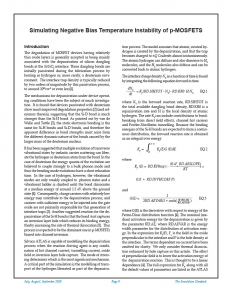Simulating Negative Bias Temperature Instability of p-MOSFETS
Introduction
The degradation of MOSFET devices having relatively thin oxide layers is generally accepted as being mainly associated with the depassivation of silicon dangling bonds at the Si/SiO2 interface. These dangling bonds are initially passivated during the fabrication process by heating in hydrogen or, more rarely, a deuterium environment. The interface trap density is typically reduced by two orders of magnitude by this passivation process, to around 1010cm-2 or even less[1].
The mechanisms for depassivation under device operating conditions have been the subject of much investigation. It is found that devices passivated with deuterium show much improved degradation properties [2] (and references therein), suggesting that the Si-D bond is much stronger than the Si-H bond. As pointed out by van de Walle and Tuttle [3], the static electronic bonding is the same for Si-H bonds and Si-D bonds, and therefore the apparent difference in bond strengths must arise from the different dynamic nature of the bonds caused by the larger mass of the deuterium nucleus.
It has been suggested that multiple excitation of transverse vibrational states by inelastic carrier scattering can liberate the hydrogen or deuterium atom from the bond. In the case of deuterium the energy quanta of the excitation are believed to couple strongly to a bulk phonon mode and thus the bending mode excitations have a short relaxation time. In the case of hydrogen, however, the vibrational modes are only weakly coupled to phonon states and a vibrational ladder is climbed until the bond dissociates at a median energy of around 1.5 eV above the ground state [4]. Consequently, charge carriers with relatively low energy may contribute to the depassivation process, and carriers with sufficient energy to be injected into the gate oxide are not primarily responsible for this generation of interface traps [2]. Another suggested reaction for the depassivation of the Si-H bond is that the bond first captures an inversion layer hole which reduces its binding energy, therby increasing the rate of thermal dissocation [5]. This process is expected to be the dominant one in p-MOSFETs biased into channel inversion.



